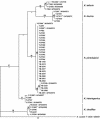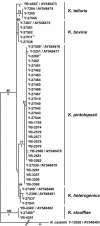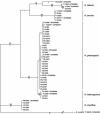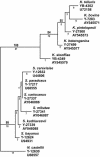Multigene phylogenetic analysis of pathogenic candida species in the Kazachstania (Arxiozyma) telluris complex and description of their ascosporic states as Kazachstania bovina sp. nov., K. heterogenica sp. nov., K. pintolopesii sp. nov., and K. slooffiae sp. nov
- PMID: 15634957
- PMCID: PMC540161
- DOI: 10.1128/JCM.43.1.101-111.2005
Multigene phylogenetic analysis of pathogenic candida species in the Kazachstania (Arxiozyma) telluris complex and description of their ascosporic states as Kazachstania bovina sp. nov., K. heterogenica sp. nov., K. pintolopesii sp. nov., and K. slooffiae sp. nov
Abstract
A yeast causing widespread infection of laboratory mice was identified from 26S rRNA gene sequences as Candida pintolopesii. To determine the relationship of C. pintolopesii with other members of the Kazachstania (Arxiozyma) telluris species complex, nucleotide sequences from domains 1 and 2 of the 26S rRNA gene, the mitochondrial small-subunit rRNA gene, and the RNA polymerase II gene were phylogenetically analyzed. That analysis resolved the 48 strains examined into five closely related species: K. telluris, Candida bovina, C. pintolopesii, Candida slooffiae, and a previously unknown species. One or more strains of each of the last four species formed an ascosporic state much like that of K. telluris. To place these ascosporogenous strains taxonomically, it is proposed that they be assigned to the teleomorphic genus Kazachstania as K. bovina (type strain NRRL Y-7283, CBS 9732, from the nasal passage of a pigeon), K. heterogenica (type strain NRRL Y-27499, CBS 2675, from rodent feces), K. pintolopesii (type strain NRRL Y-27500, CBS 2985, from the peritoneal fluid of a dead guinea pig), and K. slooffiae (type strain NRRL YB-4349, CBS 9733, from the cecum of a horse). On the basis of multigene sequence analyses, K. heterogenica appears to be a hybrid of K. pintolopesii and a presently unknown species. With the exception of K. bovina, the phylogenetically defined species show a moderate degree of host specificity.
Figures





References
-
- Groth, C., J. Hansen, and J. Piskur. 1999. A natural chimeric yeast containing genetic material from three species. Int. J. Syst. Bacteriol. 49:1933-1938. - PubMed
-
- Hurt, R. A. 1997. A molecular analysis of the relatedness of anamorphic yeasts currently classified as Candida pintolopesii. Ph.D. thesis. University of Tennessee, Knoxville.
-
- James, S. A., M. D. Collins, and I. N. Roberts. 2001. Phylogenetic analysis of the psychrophobic yeast Arxiozyma telluris and the reinstatement of Candida pintolopesii (van Uden) Meyer et Yarrow and Candida slooffii van Uden et do Carmo-Sousa. Int. J. Syst. E vol. Microbiol. 51:1917-1925. - PubMed
-
- Kreger-van Rij, N. J. W. 1958. The relationship between Saccharomyces tellustris and Candida bovina. Antonie Leeuwenhoek 24:137-144. - PubMed
-
- Kreger-van Rij, N. J. W. 1966. Taxonomy of the genus Pichia, p. 51-58. In A. Kocková-Kratochvilová (ed.), Proc. 2nd Int. Symp. Yeasts. Slovak Academy of Sciences, Bratislava, Czecholslovakia.
Publication types
MeSH terms
Substances
Associated data
- Actions
- Actions
- Actions
- Actions
- Actions
- Actions
- Actions
- Actions
- Actions
- Actions
- Actions
- Actions
Grants and funding
LinkOut - more resources
Full Text Sources
Other Literature Sources

